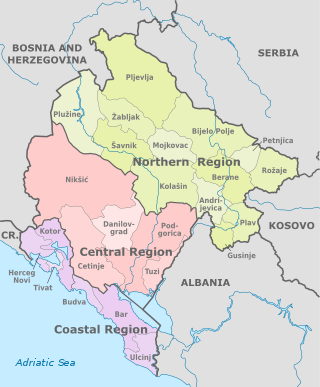Top Qs
Timeline
Chat
Perspective
Statistical regions of Montenegro
From Wikipedia, the free encyclopedia
Remove ads
The statistical regions of Montenegro (Montenegrin: statistički regioni Crne Gore / статистички региони Црне Горе) are defined, as of 2011, by the Montenegrin Regional Development Law (Zakon o regionalnom razvoju / Закон о регионалном развоју).[1] The regions, as defined by law, roughly correspond to the informal and colloquial division of Montenegro, often used by the Montenegrin media and citizens.
Regions are not administrative divisions per se; they are used for statistical and analytical purposes, to help create the outline for more uniform economic development of Montenegro. This official definition of the regions of Montenegro is one of many definitions that are in everyday use in the country. However, this division into three regions is most widespread:
Remove ads
List
Central Region
Summarize
Perspective
This region consists of six municipalities. It is the most populous of the regions, and contains the capital of Podgorica, the historical capital of Cetinje, and the industrial center of Nikšić. Most of the Montenegrin economic, cultural, educational and administration base is located within the region.
Prominent tribal, historical and geographical subregions in the central region are: Nikšići (Župa, Rudine), Golija, Banjani, Grahovo, Krivošije, Brda (Piperi, Rovca, Bratonožići, Kuči, Bjelopavlići, Lijeva rijeka), Zeta (Upper and Lower), Skenderija, Malesija, Old Montenegro (Pješivci, Čevo, Cuce, Bjelice, Njeguši, Cetinje field, Ceklin, Komani, Zagarač, Lješani and Rijeka).
Remove ads
Coastal Region
This southernmost region consists of municipalities with access to the Adriatic Sea. This region is mainly oriented towards tourism, and has a population of 146,784 (2003). Following municipalities make up the region:
Prominent tribal, historical and geographical subregions of the coastal statistical region are: Bay of Kotor, Grbalj, Budva riviera, Pobori, Brajići, Maine, Paštrovići, Spič, Crmnica, Bar, Mrkojevići, Ulcinj riviera and Skadarska Krajina.
Northern Region
Northern region comprises eleven municipalities and is the largest by area. It encompasses the sparsely populated mountainous part of Montenegro. With the decline of the heavy industries in the 1990s, the region has seen perpetual economic hardship and migration of the population to the two southern regions.
Prominent tribal, historical and geographical subregions of the northern statistical region are: Drobnjak (Uskoci, Jezera, Šaranci), Zatarje, Pljevlja, Piva, Brda (Morača (Upper and Lower), Vasojevići), Polja, Kolašin (Upper and Lower), Southern Sanjak, Plav and Gusinje, Bihor (Upper and Lower), Polimlje and Potarje.
Remove ads
See also
References
Wikiwand - on
Seamless Wikipedia browsing. On steroids.
Remove ads




























